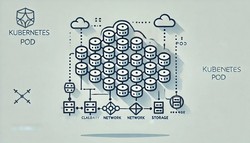Greedy Algorithm
 (Representational Image | Source: Dall-E)
(Representational Image | Source: Dall-E)
Quick Navigation:
- Greedy Algorithm Definition
- Greedy Algorithm Explained Easy
- Greedy Algorithm Origin
- Greedy Algorithm Etymology
- Greedy Algorithm Usage Trends
- Greedy Algorithm Usage
- Greedy Algorithm Examples in Context
- Greedy Algorithm FAQ
- Greedy Algorithm Related Words
Greedy Algorithm Definition
A greedy algorithm is an approach for solving optimization problems by making the most optimal choice at each step, hoping that this local optimization leads to a globally optimal solution. Greedy algorithms do not reconsider choices once made, making them efficient but not always optimal. They are commonly used in problems like graph traversal, scheduling, and resource allocation. Examples include Dijkstra’s algorithm for shortest paths and Huffman encoding for data compression.
Greedy Algorithm Explained Easy
Imagine you want to collect as many candies as possible from a candy jar, but you can only grab one at a time. You would always pick the biggest candy first because that seems like the best idea. Greedy algorithms work like that—they always choose what seems best at each step without thinking about future consequences.
Greedy Algorithm Origin
The concept of greedy algorithms emerged in computer science during the 1950s as part of early efforts in optimization and algorithm design. Their simplicity and speed made them fundamental in computational theory and practical applications.
Greedy Algorithm Etymology
The term "greedy" reflects the approach's nature of making immediate, selfish choices to achieve a goal, without looking ahead.
Greedy Algorithm Usage Trends
In recent decades, greedy algorithms have remained significant due to their speed and efficiency in solving certain types of problems. They are frequently used in network design, combinatorial optimization, and machine learning.
Greedy Algorithm Usage
- Formal/Technical Tagging:
- Optimization
- Algorithm Design
- Computer Science - Typical Collocations:
- "greedy algorithm approach"
- "greedy method"
- "Dijkstra’s algorithm"
- "greedy strategy in optimization"
Greedy Algorithm Examples in Context
- Dijkstra’s algorithm uses a greedy strategy to find the shortest path in a graph.
- Huffman coding applies a greedy approach for efficient data compression.
- The coin change problem often uses a greedy algorithm for selecting the minimum number of coins to make a given amount.
Greedy Algorithm FAQ
- What is a greedy algorithm?
A greedy algorithm makes locally optimal choices at each step to solve an optimization problem. - When are greedy algorithms used?
They are used in optimization problems like shortest pathfinding, scheduling, and data compression. - How do greedy algorithms differ from dynamic programming?
Greedy algorithms make decisions step-by-step without backtracking, whereas dynamic programming considers all possibilities to find the best solution. - Are greedy algorithms always optimal?
No, greedy algorithms provide an optimal solution only for problems that have the "greedy choice property" and "optimal substructure." - What are examples of greedy algorithms?
Dijkstra’s algorithm, Kruskal’s algorithm, and Huffman encoding are common examples. - Why are greedy algorithms important?
They are simple to implement and solve problems quickly, making them valuable in practical applications. - Can a greedy algorithm be used in machine learning?
Yes, certain heuristic search and decision-tree algorithms use greedy strategies. - What is the coin change problem in greedy algorithms?
It’s a classic problem where the goal is to make change for an amount with the minimum number of coins using a greedy strategy. - What is a real-life example of a greedy algorithm?
A cashier giving change by selecting the largest available denominations is an example. - What are the drawbacks of greedy algorithms?
They may not always lead to the best solution and can fail for problems without the greedy-choice property.
Greedy Algorithm Related Words
- Categories/Topics:
- Optimization
- Graph Theory
- Data Compression
- Algorithm Design
Did you know?
The "greedy" name might sound selfish, but these algorithms have powered technologies like data compression and GPS navigation, showing that a little greed can go a long way!
Authors | Arjun Vishnu | @ArjunAndVishnu

PicDictionary.com is an online dictionary in pictures. If you have questions or suggestions, please reach out to us on WhatsApp or Twitter.
I am Vishnu. I like AI, Linux, Single Board Computers, and Cloud Computing. I create the web & video content, and I also write for popular websites.
My younger brother, Arjun handles image & video editing. Together, we run a YouTube Channel that's focused on reviewing gadgets and explaining technology.
















Comments (0)
Comments powered by CComment